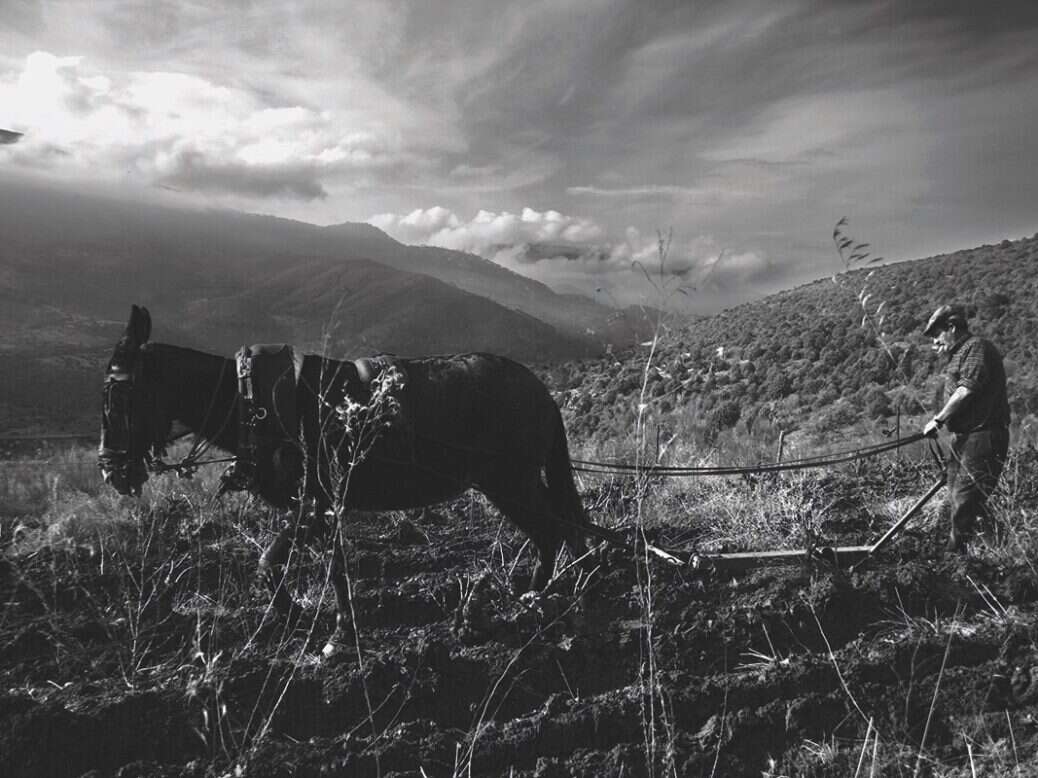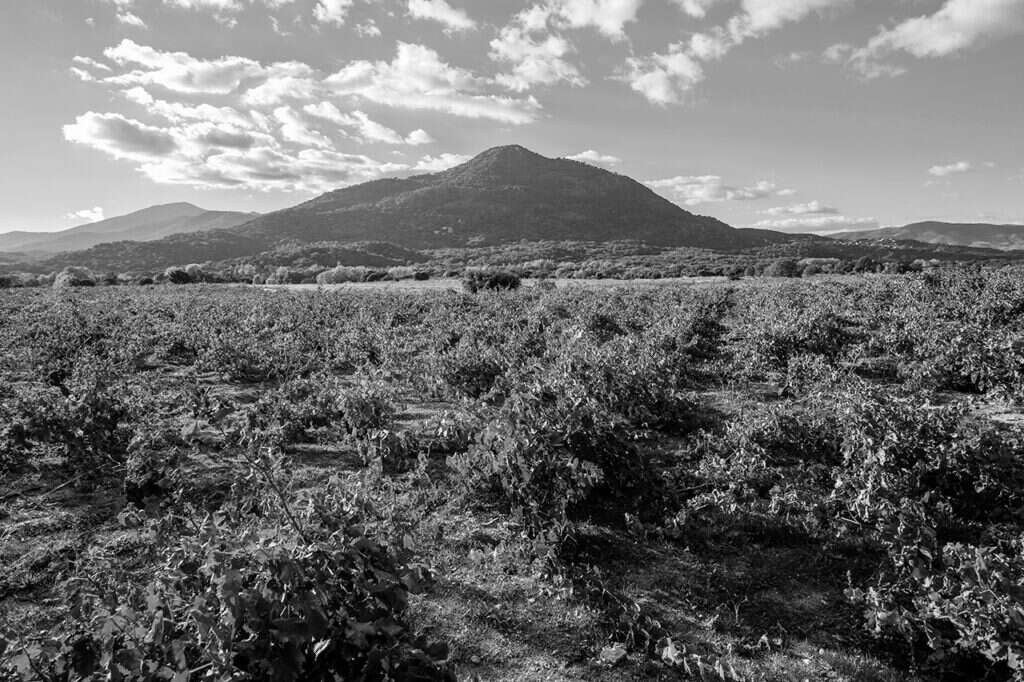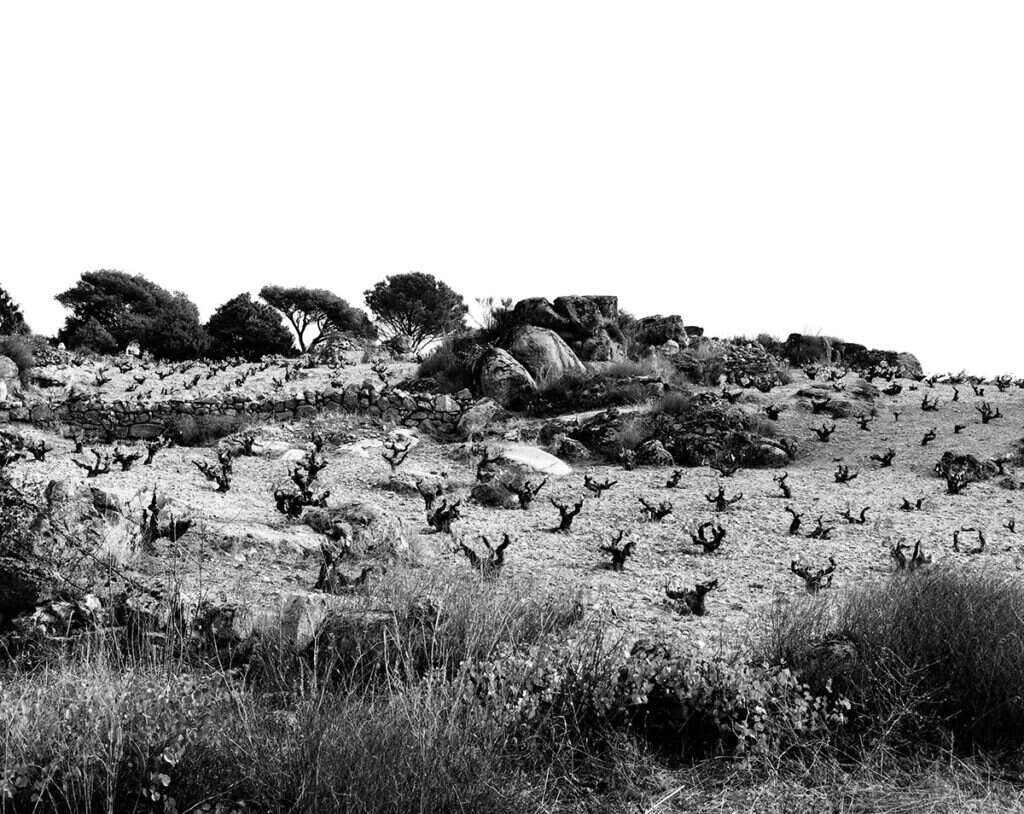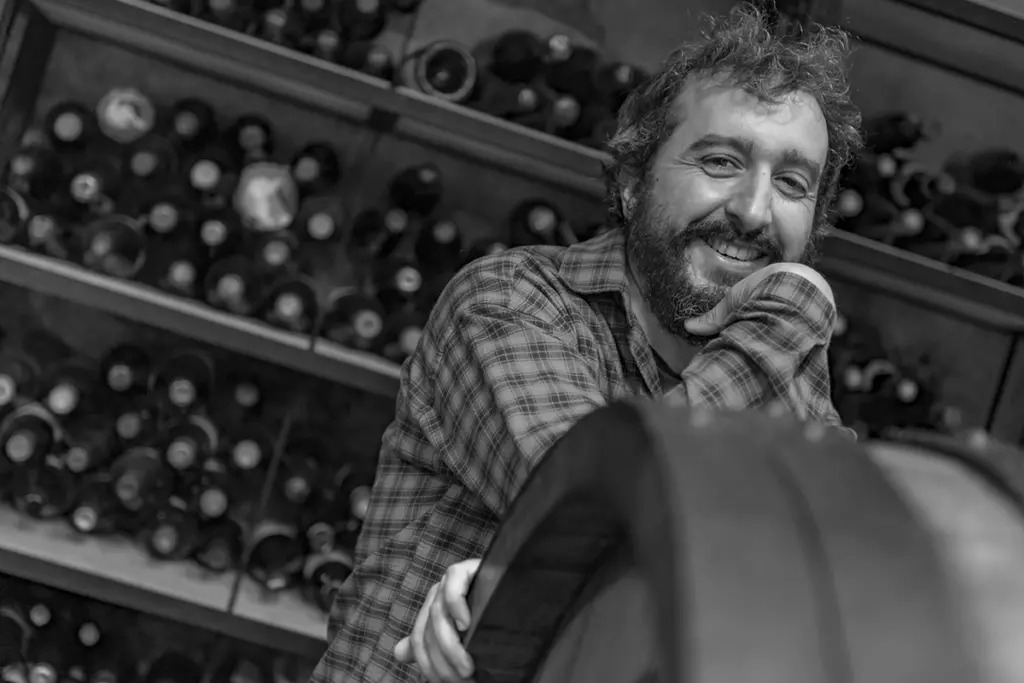
Over the past 20 years, The World of Fine Wine has published a series of in-depth pieces looking at some of the world’s most exciting and distinctive terroirs in our “Genius Loci” series. This summer we are taking the opportunity to publish some of the best of the series online for the first time, starting here with a piece from WFW67 on a very special Spanish place.
Since the turn of the millennium, the neglected old bush vines of the Sierra de Gredos mountains west of Madrid have been a magnet for some of Spain’s best young winemakers. Margaret Rand visits a breathtaking region with a burgeoning reputation for pale, elegant Garnacha and complex Albillo Real whites—despite not having a DO of its own.
The rougher the vineyard, the more illegible the notes. It’s an expression of terroir of sorts, a direct reflection of steepness of slope and rockiness of ground, a translation of complicated terrain into unintelligible writing. Notes written in the smooth, polished Médoc are easy to read. Those written in Gredos? Well…
The Sierra de Gredos, west of Madrid, has its own growing reputation but no DO of its own; and nor is it likely to get one. It deserves one, certainly, for its pure, transparent, tense Garnachas and its fresh, saline Albillo Reals, but it is inconveniently divided between three provinces—Toledo, Madrid, and Avila—and you can just imagine the sighing and the shuffling of papers and the filing under T for “too difficult” that the question of a Gredos DO would induce in any civil servant. So, Gredos, with its individual character and its particular terroirs, has to make do with three separate DOs, all of which include other regions as well: Cebreros, Mentrida, and Vinos de Madrid—four, if you count Vinos de la Tierra de Castilla y León. Some 70–85 percent of the region, however, comes into Cebreros, by Daniel Ramos’s estimate, and Cebreros is tidily enclosed within Avila, so that is probably the best that Gredos is going to get. Most of the growers make a point of mentioning Gredos somewhere on the label, back or front, but an association of Gredos producers pretty much fell apart under the pressure of conflicting interests, so the sort of thing that would help consumers to find the wines—a sticker, a neck label, a special bottle—is not likely at the moment. Like the terroir, it’s complicated.
To make things still more complicated, Gredos doesn’t look like a wine area. There just aren’t that many vineyards, and they tend to be small and scattered, perhaps half a hectare tucked into a gap in the scrubby forest or pinned onto a north-facing slope. Many have been abandoned. Gredos had its most recent heyday in the 1960s and ’70s, and it’s been downhill ever since—until, that is, some of Spain’s more enterprising winemakers discovered its old vines and its difficult-to-reach vineyards. Half a hectare of semi-abandoned 60-year-old Garnacha bush vines, overgrown with lavender and fennel, interrupted by glacial boulders and workable only by mule, is catnip to the likes of Telmo Rodríguez, who was the first to arrive, in 1999, and was transfixed by the beauty of the place. Rodríguez was followed by others, and now there’s a critical mass. None has very many vineyards—Rodríguez, with about 13ha (32 acres), reckons he’s probably the biggest, but “I had 15 years of disaster, failure.” Not because the wines weren’t good but because he was losing money on them: “The market wouldn’t accept €25 a bottle for Gredos.” And when you’re losing money on every bottle, there’s a limit to the number of hectares you can have. “We make a living because we drink it,” says Daniel Ramos. I hope he’s joking.

There are plenty of places to hunt for vines. Gredos consists of three valleys, all glacial, and all littered with enormous granite boulders, left untidily behind when the last of the glaciers departed, and sometimes weathered into faces worthy of Easter Island. In the south, there is the Valle del Tiétar, with a Mediterranean climate of rainy springs and hot summers, granite soils and green meadows. In the center is the Valle del Alberche, with a drier Mediterranean climate, vineyards at slightly higher altitudes of 1,970–2,950ft (600–900m), and granite soils. (The term “Mediterranean” here doesn’t imply any influence of that sea; it’s categorized simply according to the numbers.) The northern valley, Valle Alto Alberche, has a more extreme continental climate, vineyards at 3,280–4,100ft (1,000–1,250m), and soils of pure granite and quartz.
The granite, even in the massive boulders with overhangs big enough to picnic under, is crumbly—you can pick it off with your fingers and break it into grains. The soil is coarse granite sand, with perhaps 0.1 percent organic matter, and it can go down for 10ft (3m) before hitting rock or, on the hilltops, be so shallow that the plow will hit bedrock. In the regions where granite gives way to schist—for example, around the town of El Tiemblo—the schist is also friable and, according to Fernando García, winemaker at Comando G and Marañones, gives complex wines with more assertiveness than granite. Schist wines are easier to understand, he says; granite wines are more subtle.
Granite gives direct, narrow, linear wines, he says, and the amount of silt in the soil gives length. The silt also retains water better and gives balance in hot years. And there are of course different kinds of granite here. García reckons that brown granite gives complexity, white granite gives minerality, and pink granite gives fruit. He works with soil specialist Pedro Parra, and they have observed a correlation between the size of the quartz crystals in the granite and the tannins in the wine: the smaller the quartz crystals, the finer the tannins. They haven’t yet worked out why it should be so; just that it seems to be so. The smallest crystals are the size of a grain of salt; the biggest, perhaps 0.4in (1cm).
If the soil profiles are complicated, the weather is even more so. These are mountains and valleys, and nothing is straightforward. This part is windy; that part sheltered; this part dry, that part rainier; this is where the Africano, the hot wind from the south that arrives in July or early August, blows; here temperatures will be around 61°F (16°C) at night in August, but over there, 57°F (14°C); here veraison for Garnacha will be around August 10, but over there, at the end of August—but if you lose track of this, the vegetation will tell you. You can go from a green landscape of Spanish chestnuts and poplars and rock rose, to a dried-out one of sparse holm oak, umbrella pines, fennel, and lavender in a couple of twists of the road. The altitude—and the different altitudes—is also vital to style. Clearly, a wine grown at 2,300ft (700m) is going to be different from one grown at 3,940ft (1,200m).
From vicious to virtuous circle
But why has it been so neglected? Or rather, why was it abandoned? Phylloxera arrived late here, in the 1930s, and then came civil war. But the region supplied wine to Madrid, and there were a great many vineyards, and each village had its cooperative cellar. Then when the railway from Valdepeñas to Madrid was built, Gredos found that its hard-to-work, often terraced vineyards could not compete, and as the 20th century progressed it descended into a vicious circle of low prices and diminishing demand. When the likes of García arrived (Bodegas Marañones started in 2008), you could buy a liter of old Garnacha for 60c from the local co-op, which paid growers 10–15c for a kilo of grapes. Rodríguez says his grapes cost him €4 a kilo to produce: without an additional income from work elsewhere, it wouldn’t make sense. The 4,000ha (9,884 acres) that comprise the whole region now would have been what one village had back in the 1970s. The co-op in San Martín de Valdeiglesias, for example, handled 14 million kg (15,400 tons) of grapes a year in the 1990s; by the 2000s this was down to 3 million kg (3,300 tons); now it’s around 300,000kg (330 tons).
You might guess that the sort of people who pounce on old Garnacha vines now, who revel in the mixed landscape and will put up with yields of 20–25hl/ha for Garnacha and less, perhaps 10–15hl/ha for Albillo Real, are not going to be conventional in their methods—or necessarily agree with each other. Biodynamism and organics rule, though there’s nothing particularly unconventional about that now; most aren’t certified. Natural yeasts rule in the wineries: Again, that’s predictable. Foot-treading is less predictable, and there’s quite a lot of it here, “for very gentle extraction,” says García. “It’s less formal than for Port.” At Bodegas Canopy, for example, Alfonso Chacón Gil might put whole bunches in a plastic vat and foot-tread to break the grapes but not the stems, to avoid green tannins. The wineries contain every possible sort of fermentation vessel: old concrete, in old co-op cellars; stainless steel from tiny up to small; plastic tubs; eggs; amphorae; wood of different shapes and sizes, but nearly always old. The aim is delicacy, freshness, and lightness combined with concentration, and this is where they’re really ahead of the curve. Says (Aussie-born) Daniel Ramos, “I don’t look at color in winemaking. […] I don’t care much about alcohol, acid, anything—but I care about balance.” In their hands, Garnacha is revealed as something intensely aromatic, full of notes of rosehips and lavender, incense and thyme, violets and fennel, grippy, tight, and tense. There is not a hint of jamminess, not a whiff of opulent chocolate prunes. This is Garnacha as crystalline and pristine as Pinot Noir. These are extreme wines. Extremely Burgundian? Sometimes.

García’s description of perfect Garnacha grapes sounds like back to the future. Balance lies in not having small berries, he says: He wants medium to big clusters, to have more juice. He also likes a bit of pink in a bunch of Garnacha, and occasionally even a bit of green; dry and botrytized grapes are removed on the sorting table. (The same goes for Albillo Real, of which more later; the clusters are gold when they pick, with a bit of green inside.) He’s not looking for tiny yields per vine, because that way lies jamminess. “With Tempranillo, you want perfect ripeness, but we like green stems for Garnacha. We don’t want phenolic ripeness of the stems. If you have yellow stems you get 16% alcohol. The seeds are completely green at picking, but we extract nothing from the seeds.
“The tannins of Tempranillo are different. If you treat Garnacha like Tempranillo, you get trouble. We have gentle extraction, so we don’t extract green tannins.” Early in the process, he says, the juice is fruity-tasting; then, after 30–40 days it just looks like green water—“horrible, and tannic. Then after 45–50 days, it becomes floral, and at 60 days, it’s mineral.”
This approach is not universal. Some, like winemaker Maite Sánchez Márquez of Bodegas Arrayán, say openly that they’re influenced by Burgundy, while Rodríguez, for one, favors more ripeness. “My idea is to produce a Gredos wine, not a Burgundy. We know a lot about Garnacha, and we’ve worked with it for many years”—in the Rhône, too, with the Perrins. When he arrived in Gredos, he got in touch with François Perrin again, “because I had potentially 16% alcohol. He said, ‘Remember that my own best Grenache is always more than 15%.’”
“‘Below 14.7% is difficult,” agrees Sánchez Márquez. But delicacy, not density, is always the aim. Juan Diez Bulnes at Bernabeleva says that “here we are comfortable with low yields from old vines, but not massive concentration. Sixteen buds, even 20, per plant is fine. Nine to 12 is too few.” I tasted only one sweetly ripe, international-style Garnacha while I was there, and even its maker didn’t seem to like it all that much.
There’s often also a social aspect to these ventures: The vultures you sometimes see circling overhead are not a metaphor for incoming predators. Jésus Maria Soto and Bárbara Requejo are at Sotomanrique, which also runs the co-op in Cebreros, and wines made from the co-op grapes are now being exported. García and his partner at Comando G, Daniel Landi, also work with a local co-op to help it improve. (To clarify: Dani Landi’s family company is called Bodega Jiménez-Landi. His own is called Daniel Gómez Jiménez-Landi, and he is also a partner in Comando G.) It helps to fix people in the area and halt the cycle of abandonment. The co-ops pay more for grapes now: double, says García; 50c a kilo, and up to €1.60/kg for the best plots, say Soto and Requejo. And, says García, “A couple of growers have begun to plant again. Small beginnings, but still…”

Distinctive terroir and varieties
It was the vineyards that drew new growers here: always the vineyards and the landscape. (They have the same effect on visitors now: Do I have to go home? Can’t I just live here?) Landi and García would spend every Tuesday afternoon driving around with the aid of Google Maps and the odd shepherd, who would tell them yes, there are vines up there, but they shouldn’t bother because it’s hard to get there and not very good—so up they would go. Then would come visits to the local bars, asking if anyone knew the owner.
Is it easy to persuade owners to sell? Some say yes, some say no. Rodríguez says, “You have to go in a very nice way, starting slowly, knowing people.” Diez Bulnes says there are two kinds of growers: “Those who would rather abandon a vineyard than rent or sell it—they’ll say, ‘So, you want to make money out of my family’s vineyard?’ At the other extreme, they’ll tell you that you’ll rent their vineyard—they’ve decided you will—whether you want to or not.” The owners know the new value of their land, too. The first arrivals, when they could buy, paid around €10,000 per hectare. Now values are up to €60,000/ha. Ribera del Duero, they say, is around €40,000–50,000/ha. The vines are often very old—one of Daniel Ramos’s vineyards was planted in 1905, and each elderly (bush) vine is supported by a stone to stop it falling over and then making its own roots. Nobody knows quite how much of a danger phylloxera would be in these gritty, sandy soils, but there’s no point in taking the risk with such old vines.
Who was first here? Telmo Rodríguez arrived in 1998–99. Daniel Ramos says that “Telmo started in San Martín; I was working for him and called his attention to Cebreros.” Others followed early in the new century. “When I came to Gredos,” says Rodríguez, “it was, for me, an education; they worked as in the Middle Ages. Nothing had ever changed. Nobody had ever arrived to tell them to work differently. They used herbicides, and they pruned and did a couple of treatments with sulfur, and that’s all they did. So, the vineyards recovered very quickly.”

It’s worth noting that Garnacha itself seems to be a bit of an in-comer. Until the 1890s, says Daniel Ramos, the red grape was Listán Negro, but the attraction of Garnacha was its sugar levels. You’ll find every kind of Garnacha here now—white, gray, black, peluda—but nobody seems to think there’s that much genetic variation, which is consistent with it being a recent arrival. There are other vines, too, often mixed in: Listán, Morete, Godello, Cariñena, Muscat for sweet wine, a bit of Marsanne and Rousanne, a bit of Verdejo, Macabeo… Península Vinicultores makes (among other beauties) a compelling, clove-carnation-scented field blend of Garnacha, Rufete, and Piñuela.
The flagship white grape is Albillo Real, which deserves more attention than it’s had so far in this piece, because these are really remarkable wines; and Gredos is just about the only place you’ll find them. It’s been here since the 17th century, and maybe before. Its wines have texture, depth, and complexity. Chill them right down and they’re steely, but they’re more complex at cool room temperature, still taut and tense, and full of layers of honey, jasmine, salt, chamomile, honeysuckle, citrus pith, and herbs. But its balance is not based on acidity, and it needs precision, and a bit of grip from the skins, to have freshness. It takes well to full fermentation on the skins, becoming savory, with orange-peel notes—there’s always a danger of auto-suggestion with orange wines—and orange or white, it has the weight for food.
The vine is low growing, fast growing, and loves hot years and hot terroirs—Garnacha prefers the cooler ones. It’s low in acid and puts on sugar at the rate of 1% potential alcohol per day if it feels like it: ten days between veraison and harvest is fine for Albillo Real; it’s not a vine to grow if you want to go away in August. For Garnacha here, it’s 40–45 days. Albillo Real, though, used to be sold as a table grape or made into wine for home consumption; the first commercial wines seem to have been made only about ten years ago. The more traditional style—kept in a domestic cellar in barrel, and served for special occasions and topped up intermittently—grows flor and then oxidizes to rancio flavors, sweet and dark. Ruben Díaz Alonso makes a beeswax-scented Albillo Real made with a 30-day maceration; Daniel Ramos makes an elegant yellow-flowers-and-dried-
apricot-orange version. Benabeleva’s white Manchomuelas is fascinating and complex, Bodegas Marañones Picarana is honeyed jasmine with a bitter edge. There aren’t as many whites as reds, but they’re beautiful.
And what of the reds in the future? Rodríguez says, “I started in an industry that had oak as an argument. Today, I don’t know one young producer in Spain using oak as an argument. We have stopped.” As the pendulum swings inexorably toward delicacy and freshness, what will make Gredos unique? Other regions have altitude; other regions have granite. But not many have both, plus Gredos’s complicated weather patterns, its old vines—and its difficulties and costs. It’s just a pity it will probably never have its own DO.






